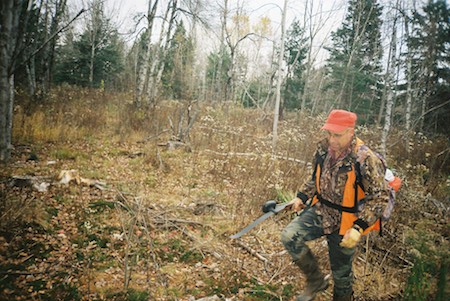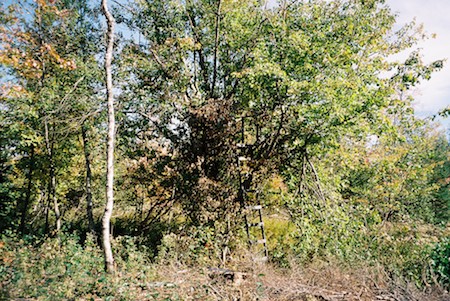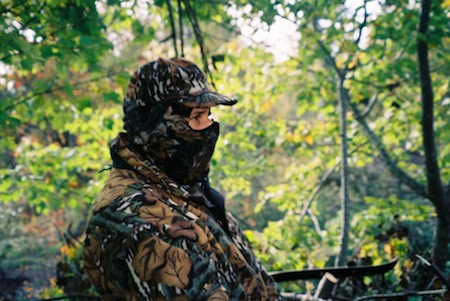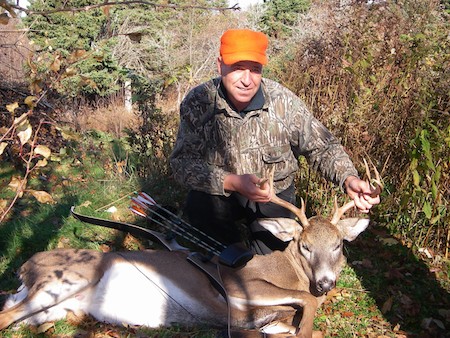After lunch, I pondered my options for the afternoon. The dogs were stiff from this morning and had no real objection when I suggested that they stay on the futon. We had enjoyed several hours of searching some favorite covers for grouse and woodcock near my New Brunswick home. No birds had been taken, and I had not seen any deer sign in any of the places that I had expected. I was also feeling stiff and tired, but it was the third week of bow season and I was overdue for a close encounter with a whitetail. I packed up my archery gear and got ready.
The weather had been mild; I dressed light, brought along some extra clothes and looked forward to a few hours sitting in a favorite treestand. As I walked, I searched for sign, and at the bottom of the hill I found a very large deer track. It was not there yesterday and I reminded myself that whitetails are often restless in October and a mature buck can show up at any time.
 I checked around the orchard for sign, and the evidence revealed that at least one deer and one or more porcupines had been feeding in the past 12 hours. I sprinkled out some welcoming drops of doe scent, climbed up the ladder, put on an extra layer and got comfortable.
I checked around the orchard for sign, and the evidence revealed that at least one deer and one or more porcupines had been feeding in the past 12 hours. I sprinkled out some welcoming drops of doe scent, climbed up the ladder, put on an extra layer and got comfortable.
It was a quiet afternoon, overcast, with the just the hint of a wind from the west. I sat quietly, didn’t move. After about 20 minutes I may have succumbed to a brief snooze. The treestand is a comfortable place for an extended sit but I awoke feeling stiff with a kink in my neck. Maybe as a result of my aches and pains, I started to question my resolve. I had already invested about 40 hours but had not seen a legal target. The orchard consistently attracts whitetails, even in years when there is no fruit, and the tracks confirmed that they must be moving after dark.
I tried to stay focused–re-directed my thoughts to images of approaching deer–and around 6 o’clock I spotted something out of place. My eyes were drawn to a curious gray form, and then to the movement, so I studied it closely.
A shadow ghosted through the trees. It was only about 40 yards away, and from the gait I soon recognized that a deer was approaching. I slowly reached for my binoculars, and after a few minutes of scanning I recognized the shoulder of a whitetail. It was obscured by low bush so I couldn’t see antlers and couldn’t really judge the size of the body. I quietly pushed my chair to the back of the stand, picked up my bow and also kept my camera ready. If nothing else, I looked forward to practice drawing on an animal and maybe getting some pictures. Nothing happened, and initially I figured that the deer had continued on a well-concealed escape route. But, after a few more minutes, a large whitetail silently emerged from the vegetation.
Right away I spotted antlers–wide antlers, much wider than its shoulders–and I made an effort to avoid eye contact and only look indirectly at the body. I didn’t count but recognized that this was the massive 8-pointer that I had been expecting.
 |pagebreak|
|pagebreak|
I have heard or read hundreds of stories by other bowhunters cautioning about the need to stay extra calm in close quarters. Deer are always on the lookout for predators, and they can somehow sense when a carnivore is planning an attack. Mature whitetails, especially bucks, get big for a reason; only seldom do they make a mistake. I don’t understand the specifics, but believe in some type of sixth sense. And at close range, even people can feel the presence or the stare of a predator.
The buck was less than 20 yards away but facing directly toward me. It lowered its body and wasn’t grazing but seemed to be testing the ground for scent. I couldn’t tell if it was cautious or curious, but it stayed in the same spot for about 10 minutes and appeared to be slowly stroking its chin on the ground or maybe checking some low vegetation. It was completely relaxed and it made contented, low humming sounds.
I had my bow arm extended, an arrow nocked and fingers on the string but the animal was facing me and no shot was offered. With its neck stretched out, it revealed the length and mass of its body. This was an absolute monster, and for most people a once in a lifetime encounter. After sitting completely motionless, I had an almost overwhelming feeling of the chills and had to brace my elbows against the branches to stop from shaking. It did the trick and I was able to slowly flex my cold muscles without moving my body. I silently reminded myself to stay with the program, not to make eye contact and wait for the vitals to be exposed before picking a spot.
As I waited I pondered the one in a million variables that had placed the animal in front of me. How many things and events had to align across the universe to direct this whitetail to this exact spot? This was not a slam dunk, monster–bucks don’t get big from being careless–and a thousand things could go wrong at the last moment and prevent a clean shot.
 After another 10 minutes, the animal checked my back trail and I watched closely. It didn’t react negatively and it appeared indifferent to the human scent. It was getting dark and I was quickly running out of shooting light. Right on schedule everything fell into place. The buck slowly turned broadside to me, and when its head was blocked by a branch, I got ready for a shot. It was only 12 yards away. I fully extended my bow arm and waited for the front leg to move and completely expose the vitals. The animal was relaxed and intuitively I recognized a perfect shot opportunity. I slowly drew and picked a spot about one hand width behind the elbow. I was immersed in the zone and I visualized the broadhead’s point of entry, and the exit, right through the animal.
After another 10 minutes, the animal checked my back trail and I watched closely. It didn’t react negatively and it appeared indifferent to the human scent. It was getting dark and I was quickly running out of shooting light. Right on schedule everything fell into place. The buck slowly turned broadside to me, and when its head was blocked by a branch, I got ready for a shot. It was only 12 yards away. I fully extended my bow arm and waited for the front leg to move and completely expose the vitals. The animal was relaxed and intuitively I recognized a perfect shot opportunity. I slowly drew and picked a spot about one hand width behind the elbow. I was immersed in the zone and I visualized the broadhead’s point of entry, and the exit, right through the animal.
When I select a target, even a zucchini, I like to be confident. As a habit, I always take an extra full second to align everything–toes right through to fingers–before releasing. If I am relaxed, and everything is perfectly lined up, at close range I can consistently insert an arrow into a target the size of an apple.
A clean miss is something to laugh about, but a poor shot is something that I would have to live with, and this was not something to rush. I was perfectly aligned and took a breath. Just before I could release, the animal leapt away. I didn’t move and I tried to redirect my thoughts to non-predatory things. I tried to picture vegetarian images of crisp broccoli tops, lush clover and ripe apples, but not juicy red meat. The buck only made one big jump, then stopped and turned almost broadside but angling slightly toward me. It was curious but fully alert and ready to bound away in an instant. I was still at full draw, instinctively lined up on the lethals, but I hesitated. It was almost 30 yards away, and under perfect conditions I may have tried a shot, but not today. The light was failing, and the front leg was in a poor position. The buck vanished before I could reconsider.
I was almost overwhelmed, not by excessive heart rate or rapid breathing, but I was consumed by the shakes and chills. I guess the surge of adrenaline was gone. I thanked the creator of everything wild and the spirits of all the hunters that watch over me, for the experience.
I have had lots of close encounters with whitetails, touched several living animals, and even wrestled with a buck, but I had never experienced 20 minutes within spitting distance of a monster. It had been another important lesson. It reconfirmed that I had the necessary skills and that I was more than worthy of taking a monster buck with traditional archery gear.
It had been a great day in the woods and a close encounter with a deer, let alone a massive buck, was just a bonus. I was content with the outcome and silently prayed that I would be invited to meet again. I sat until it was completely dark, then I crawled down from my perch and doubled back up the old road. I was still two kilometers from home and discovered that I forgot to bring my flashlight, but it was a route that I knew intimately. I had been chilled from sitting and welcomed the chance to stretch, walk and warm my core. As I walked, I pondered how I should spend tomorrow.
Author’s Bio: Ted recently retired from a career as a biologist with the Department of Fisheries and Oceans Canada. Most of his hunting is conducted within walking distance of his home in Ammon, New Brunswick, Canada. He is a southpaw and hunts with a 50#, Bear Super Kodiak.



Leave A Comment